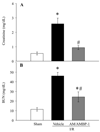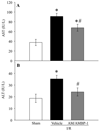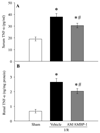Attenuation of renal ischemia and reperfusion injury by human adrenomedullin and its binding protein
- PMID: 20538296
- PMCID: PMC2922411
- DOI: 10.1016/j.jss.2010.03.064
Attenuation of renal ischemia and reperfusion injury by human adrenomedullin and its binding protein
Abstract
Background: Acute renal failure secondary to ischemia and reperfusion (I/R) injury poses a significant burden on both surgeons and patients. It carries a high morbidity and mortality rate and no specific treatment currently exists. Major causes of renal I/R injury include trauma, sepsis, hypoperfusion, and various surgical procedures. We have demonstrated that adrenomedullin (AM), a novel vasoactive peptide, combined with AM binding protein-1 (AMBP-1), which augments the activity of AM, is beneficial in various disease conditions. However, it remains unknown whether human AM/AMBP-1 provides any beneficial effects in renal I/R injury. The objective of our study therefore was to determine whether administration of human AM/AMBP-1 can prevent and/or minimize damage in a rat model of renal I/R injury.
Methods: Male adult rats were subjected to renal I/R injury by bilateral renal pedicle clamping with microvascular clips for 60 min followed by reperfusion. Human AM (12 microg/kg BW) and human AMBP-1 (40 microg/kg BW) or vehicle (52 microg/kg BW human albumin) were given intravenously over 30 min immediately following the clip removal (i.e., reperfusion). Rats were allowed to recover for 24 h post-treatment, and blood and renal tissue samples were collected. Plasma levels of AM were measured using a radioimmunoassay specific for rat AM. Plasma AMBP-1 was measured by Western analysis. Renal water content and serum levels of systemic markers of tissue injury were measured. Serum and renal TNF-alpha levels were also assessed.
Results: At 24 h after renal I/R injury, plasma levels of AM were significantly increased while plasma AMBP-1 was markedly decreased. Renal water content and systemic markers of tissue injury (e.g., creatinine, BUN, AST, and ALT) were significantly increased following renal I/R injury. Serum and renal TNF-alpha levels were also increased post injury. Administration of human AM/AMBP-1 decreased renal water content, and plasma levels of creatinine, BUN, AST, and ALT. Serum and renal TNF-alpha levels were also significantly decreased after AM/AMBP-1 treatment.
Conclusion: Treatment with human AM/AMBP-1 in renal I/R injury significantly attenuated organ injury and the inflammatory response. Thus, human AM combined with human AMBP-1 may be developed as a novel treatment for patients with acute renal I/R injury.
Copyright 2010 Elsevier Inc. All rights reserved.
Figures





Similar articles
-
Adrenomedullin and adrenomedullin-binding protein-1 downregulate inflammatory cytokines and attenuate tissue injury after gut ischemia-reperfusion.Surgery. 2007 Feb;141(2):245-53. doi: 10.1016/j.surg.2006.05.017. Epub 2006 Sep 14. Surgery. 2007. PMID: 17263982
-
Adrenomedullin and adrenomedullin binding protein-1 prevent acute lung injury after gut ischemia-reperfusion.J Am Coll Surg. 2007 Aug;205(2):284-93. doi: 10.1016/j.jamcollsurg.2007.03.012. Epub 2007 Jun 21. J Am Coll Surg. 2007. PMID: 17660075
-
Human adrenomedullin and its binding protein attenuate organ injury and reduce mortality after hepatic ischemia-reperfusion.Ann Surg. 2009 Feb;249(2):310-7. doi: 10.1097/SLA.0b013e3181961d43. Ann Surg. 2009. PMID: 19212187 Free PMC article.
-
The critical role of adrenomedullin and its binding protein, AMBP-1, in neuroprotection.Biol Chem. 2012 May;393(6):429-39. doi: 10.1515/hsz-2012-0103. Biol Chem. 2012. PMID: 22628306 Review.
-
Adrenomedullin and adrenomedullin binding protein-1: their role in the septic response.J Surg Res. 2003 Feb;109(2):175-81. doi: 10.1016/s0022-4804(02)00086-0. J Surg Res. 2003. PMID: 12643861 Review.
Cited by
-
Neuroimmune Mechanisms in Signaling of Pain During Acute Kidney Injury (AKI).Front Med (Lausanne). 2020 Aug 7;7:424. doi: 10.3389/fmed.2020.00424. eCollection 2020. Front Med (Lausanne). 2020. PMID: 32850914 Free PMC article. Review.
-
Post-treatment with the combination of 5-aminoimidazole-4-carboxyamide ribonucleoside and carnitine improves renal function after ischemia/reperfusion injury.Shock. 2012 Jan;37(1):39-46. doi: 10.1097/SHK.0b013e31823185d7. Shock. 2012. PMID: 21841537 Free PMC article.
-
Adrenomedullin Mitigates Doxorubicin-Induced Nephrotoxicity in Rats: Role of Oxidative Stress, Inflammation, Apoptosis, and Pyroptosis.Int J Mol Sci. 2022 Nov 23;23(23):14570. doi: 10.3390/ijms232314570. Int J Mol Sci. 2022. PMID: 36498902 Free PMC article.
-
Adrenomedullin and Adrenomedullin-Targeted Therapy As Treatment Strategies Relevant for Sepsis.Front Immunol. 2018 Feb 19;9:292. doi: 10.3389/fimmu.2018.00292. eCollection 2018. Front Immunol. 2018. PMID: 29520277 Free PMC article. Review.
-
Sildenafil activates antioxidant and antiapoptotic genes and inhibits proinflammatory cytokine genes in a rat model of renal ischemia/reperfusion injury.Int Urol Nephrol. 2015 Nov;47(11):1907-15. doi: 10.1007/s11255-015-1099-5. Epub 2015 Sep 16. Int Urol Nephrol. 2015. PMID: 26377490
References
-
- Bellomo R, Ronco C, Kellum JA, Mehta RL, Palevsky P. Acute renal failure - definition, outcome measures, animal models, fluid therapy and information technology needs: the Second International Consensus Conference of the Acute Dialysis Quality Initiative (ADQI) Group. Crit Care. 2004;8:R204. - PMC - PubMed
-
- Lameire N, Van Biesen W, Vanholder R. Acute renal failure. Lancet. 2005;365:417. - PubMed
-
- Uchino S, Bellomo R, Goldsmith D, Bates S, Ronco C. An assessment of the RIFLE criteria for acute renal failure in hospitalized patients. Crit Care Med. 2006;34:1913. - PubMed
-
- Hou SH, Bushinsky DA, Wish JB, Cohen JJ, Harrington JT. Hospital-acquired renal insufficiency: a prospective study. Am J Med. 1983;74:243. - PubMed
-
- Liangos O, Wald R, O'Bell JW, Price L, Pereira BJ, Jaber BL. Epidemiology and outcomes of acute renal failure in hospitalized patients: a national survey. Clin J Am Soc Nephrol. 2006;1:43. - PubMed
Publication types
MeSH terms
Substances
Grants and funding
LinkOut - more resources
Full Text Sources
Other Literature Sources
Medical
Research Materials
Miscellaneous

